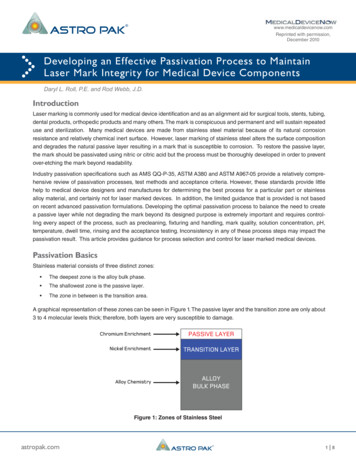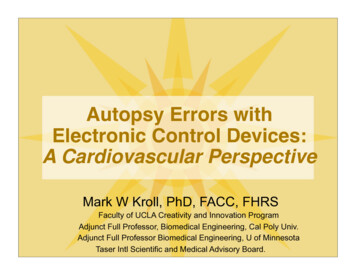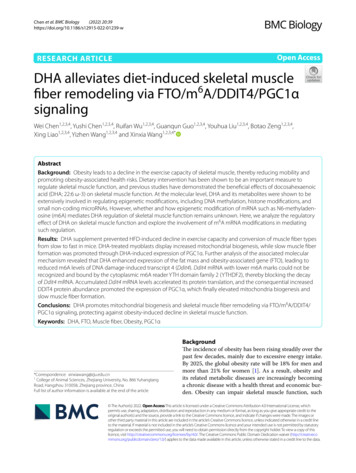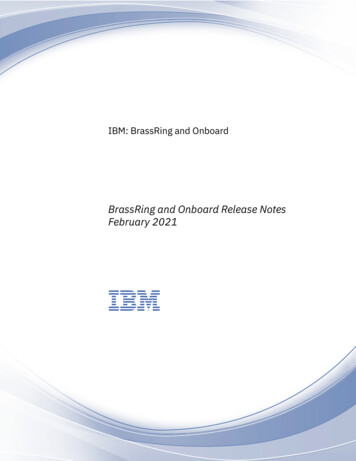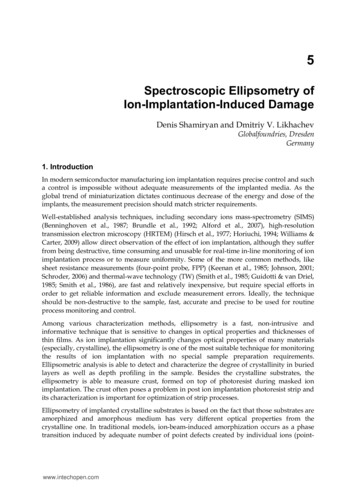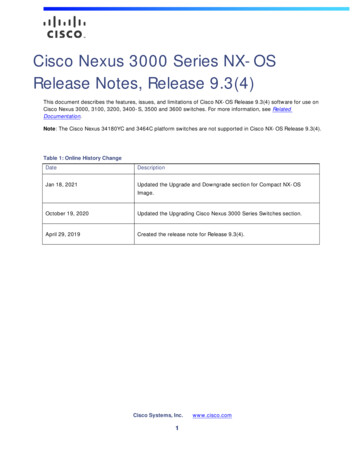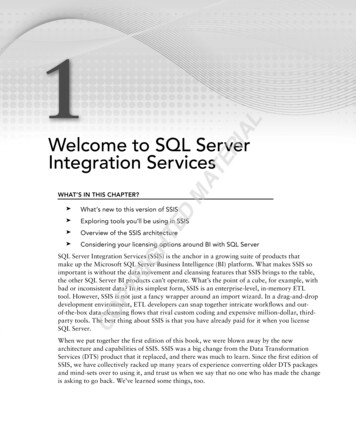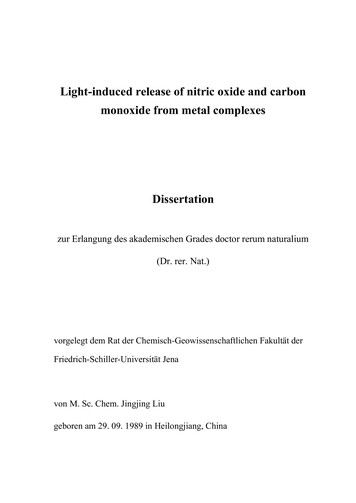
Transcription
Light-induced release of nitric oxide and carbonmonoxide from metal complexesDissertationzur Erlangung des akademischen Grades doctor rerum naturalium(Dr. rer. Nat.)vorgelegt dem Rat der Chemisch-Geowissenschaftlichen Fakultät derFriedrich-Schiller-Universität Jenavon M. Sc. Chem. Jingjing Liugeboren am 29. 09. 1989 in Heilongjiang, China
Gutachter:1. Prof. Dr. Wolfgang Weigand, Institut für Anorganische und Analytische Chemie,Friedrich-Schiller-Universität Jena2. Prof. Dr. Benjamin Dietzek, Institut für Physikalische Chemie, Friedrich-SchillerUniversität Jena3. PD. Dr. Alexander Schiller, ehemals Institut für Anorganische und AnalytischeChemie, Friedrich-Schiller-Universität JenaTag der Verteidigung: 27. 02. 2019
ContentsContentsAcknowledgements . iList of Abbreviations . ii1. Introduction . 11.1. Nitric oxide and its generation from NO releasing molecules . 21.1.1. The biological activities of nitric oxide . 21.1.2. Bonding of Nitric oxide in metal complexes . 51.1.3. Metal nitrosyl coordination complexes for NO release . 81.1.4. Photoactive release of NO from metal nitrosyl complexes . 101.2. Carbon monoxide and its generation from CO releasing molecules . 121.2.1. The biological activities of carbon monoxide . 121.2.2. Bonding of carbon monoxide in metal complexes . 141.2.3. Metal carbonyl coordination complexes for CO release . 161.2.4. Photolytic release of CO from metal carbonyl complexes . 191.3. General overview of NO and CO releasing materials . 211.3.1. NO and CO releasing molecules conjugates materials . 211.3.2. Encapsulated NO and CO releasing materials. 231.4. Scope of the thesis . 242. Fluorinated ruthenium NO releasing molecules . 252.1. Introduction . 252.1.1. Ruthenium nitrosyls for NO release . 252.1.2. Fluorescence assay for the determination NO release . 262.2. Results and Discussion . 272.2.1. Synthesis and Characterization of ruthenium nitrosyls Ru(X-Fbpb)(NO)Cl . 272.2.2. UV-Vis evaluation of Ru(X-Fbpb)(NO)Cl under illumination . 302.2.3. Fluorescence assay and investigation of the NO-release mechanism . 322.3. Summary and Conclusion . 362.4. Experimental section . 372.4.1. General procedure . 372.4.2. Synthesis and measurements . 383. Fluorinated ruthenium CO releasing molecules . 42
Contents3.1. Introduction . 423.1.1. Ruthenium carbonyls for CO release . 423.1.2. Myoglobin assay for the determination CO release . 433.2. Results and Discussion . 453.2.1. Synthesis and Characterization of ruthenium carbonyls Ru(X-Fbpb)(CO)(H2O) . 453.2.2. UV-Vis evaluation of Ru(X-Fbpb)(CO)(H2O) under illumination . 483.2.3. Myoglobin assay for ruthenium carbonyl complexes and investigation of the CO-releasemechanism . 503.2.4. Quantitative 19F NMR analysis for Ru(6-Fbpb)(CO)(H2O) upon irradiation . 523.3. Summary and conclusion . 543.4. Experimental section . 553.4.1. General procedure . 553.4.2. Synthesis and measurements . 574. Fluorinated manganese CO releasing molecule . 604.1. Introduction . 604.1.1. Quantitative 19F NMR spectroscopy . 604.1.2. Manganese tricarbonyl CORMs . 614.2. Results and Discussion . 634.2.1. Synthesis and Characterization of CORM-FBS . 634.2.2. UV-Vis evaluation of ligand and CORM-FBS under illumination . 654.2.3. Myoglobin assay for CORM-FBS and investigation of the CO-release mechanism . 664.2.4. Characterization of the inactive product after irradiation . 684.2.5. Quantitative 19F NMR analysis for CORM-FBS upon irradiation . 704.3. Summary and Conclusion . 734.4. Experimental section . 744.4.1. General procedure . 744.4.2. Synthesis and measurements . 775. Light-responsive paper strips as CO releasing material. 795.1. Introduction . 795.1.1. The introduction of dabsyl chromophore . 795.1.2. Evaluation CO release from CORMs under solvent free conditions. 795.2. Results and Discussion . 81
Contents5.2.1. Synthesis and Characterization of CORM-Dabsyl . 815.2.2. UV-Vis evaluation of ligand and CORM-Dabsyl under illumination . 825.2.3. Myoglobin assay for CORM-Dabsyl and investigation of the CO-release mechanism . 845.2.4. Characterization of the inactive product after irradiation. . 865.2.5. Toxicity of CORM-Dabsyl against human cell lines . 885.2.6. Light-induced CO-release from paper strips . 885.3. Summary and conclusion . 915.4. Experimental section . 925.4.1. General procedure . 925.4.2. Synthesis and measurements . 936. Colorimetric and fluorometric responsive photo-CORM . 966.1. Introduction . 966.1.1. The introduction of NBD group . 966.1.2. Biological studies of CO releasing molecules . 976.2. Results and Discussion . 986.2.1. Synthesis and Characterization of CORM-NBD. 986.2.2. UV-Vis evaluation of ligand and CORM-NBD under illumination. 996.2.3. Myoglobin assay for photo-CORM and investigation of the CO-release mechanism . 1016.2.4. Characterization of the inactive product after irradiation . 1046.2.5. Light-induced CO-release from alumina TLC plates . 1056.2.6. Toxicity of CORM-NBD against human cell lines . 1066.3. Summary and Conclusion . 1086.4. Experimental section . 1096.4.1. General procedure . 1096.4.2. Synthesis and measurements . 1107. Summary. 1138. Zusammenfassung . 1159. References . 118Declaration of Originality . 126
AcknowledgementsAcknowledgementsFirst and foremost, I would like to thank my supervisor Priv.-Doz. Alexander Schiller for hisguidance and support throughout the completion of my program as a doctoral student. I wish tothank him for giving me the opportunity to join his group and work on this interesting field. I amhighly indebted for his time and patience to help me adapt to a foreign environment and guide meinto PhD projects step by step. Dr. Schiller taught me not only how to perform scientific research,but also positive attitude towards life. I also deeply appreciate his encouragement and advice inbusy schedule during my period of thesis-writing. It is really difficult to overstate my gratitude toProf. Schiller, thank you so much!Also I wish to thank Dr. Gandra Upendar Reddy for his help and patience with my manyquestions. I learnt a lot from him. I am grateful with Steve Gläser for help to familiarize withdoctoral procedure, laboratory and Zusammenfassung. I want to thank the whole Schiller group:Dr. Vadde Ramu, Jörg Axthelm and Dr. Carmen Bohlender. I wish to also sincerely thank Dr.Peter Bellstedt and Dr. Friederike Pielenz for their technic analysis of samples withF NMR19spectroscopy, Dr. Johannes Steinmetzer for his computer studies and assistance of DFTcalculations, Dr. Patrick Hoffmann for his cell studies and Dr. Helmar Görls for the determinationof single crystal X-Ray analysis. Special thanks go to the technical staff of the organic andmacromolecular institute and the inorganic and analytical institute for analytical investigation.I offer my regards and blessings to my parents and my friends for their support in any respectduring my PhD study in Germany.Finally, I wish to thank the Chinese scholarship Council (CSC) for financially support during thePhD program which allowed me to study and work with such excellent scientists in Germany andalso the German Research Foundation (DFG) for scientific research.i
List of AbbreviationsList of AbbreviationsNONitric oxideCOCarbon monoxideNORMNitric oxide releasing moleculesCORMCarbon monoxide releasing moleculesNORMAsNitric oxide releasing materialsCORMAsCarbon monoxide releasing materialsHOMOThe highest occupied molecular orbitalLUMOThe lowest unoccupied molecular orbitalDMFN,N-dimethylformamideDMSODimethyl sulfoxideACNAcetonitrileNMRNuclear magnetic resonanceIRInfrared spectroscopya.uArbitrary unitsMLCTMetal to ligand charge transitionppmParts per millionESIElectrospray ionizationEPREnhanced permeability and retentionMSMass spectrometryUVUltraviolet lightVisVisible lightÅÅngströmδChemical shiftCHCyclohexaneii
Introduction1.IntroductionNitric oxide (NO) and carbon monoxide (CO), over the past several decades, have beenconsidered as toxic gases, which are environmentally damaging or deadly to humans and animalsat high concentrations.[1-4] However, since 1990s they have been well established as the famousgaseous signaling molecules (gasotransmitters), displaying notable chemical reactivity, includinghydrogen sulfide (H2S).[1]They are considered as messenger molecules that have diversefunctions on and are involved in numerous bioregulatory pathways. Various animal models havedemonstrated that these labile biological mediators diffuse into adjacent cells to interact with theirtargets, to reduce leukocyte adherence in the blood vessels, to be anti-inflammatory and to reduceblood vessel restenosis.[1-6]Thus, an appropriate amount of gasotransmitters delivery can lead topositive effects on inflammation and wound healing, which attracts considerable therapeuticinterest.[2–4]This chapter will separately introduce the biological identities and activities ofmolecule species in organism systems. A brief description of the mechanism of species (NO orCO) and species donors during the process of releasing signal molecules on targeted sites will begiven. The term “donor” implies that the compound releases the active mediator. Accordingly,these donors that release desired quantity of NO or CO to cells and tissues are called nitric oxidereleasing molecules (NORMs) or carbon monoxide releasing molecules (CORMs) can bedeveloped as potential therapeutic agents. In addition, their development in recent progress willbe presented and the discussion of relevant drugs (NORMs and CORMs) that release NO or COunder light triggered conditions will be clearly illustrated. Meanwhile, this section will alsointroduce the application of these chemical compounds that can be used for controlled drugdelivery, which generally recognized as NO releasing materials (NORMAs) or CO releasingmaterials (CORMAs).1
Introduction1.1.Nitric oxide and its generation from NO releasing molecules1.1.1. The biological activities of nitric oxideNitric oxide (NO) was long thought of as a simple, common air pollutant, which is formed fromthe oxidation of nitrogen and incomplete combustion of gasoline, for instance in automobileexhaust fumes. However, in 1867, Thomas Lauder Brunton first reported the therapeutic use ofexogenous NO prescribed to rapid relief of angina pectoris in ischemic patients, whichsurrounded considerable controversy and was not recognized at the time due to his incorrectinterpretation of the background of angina pectoris.[5–8]Maseri et al. in 1977, concluded theexplanations of the effects of nitrates presented by Lewis and Gorlin, and established that thedrugs could release coronary spasm and dilate the peripheral venous capacitance vessels due totheir capability of dilating the coronary vessels within an ischemic myocardial domain.[7]In thesame year, Ferid Murad discovered that several nitro vasodilators improved guanylate cyclaseactivity in particulate and/or soluble preparations from various tissues. Furthermore, hespeculated that the generation of free NO from the decomposition of these agents also increasedguanylate cyclase activity and cyclic guanosine monophosphate levels in intact tissues.[9]RobertFrancis Furchgott believed that blood vessels were dilated because a new concept endotheliumderived relaxing factor (EDRF), which was probably produced by endothelial to relax vascularsmooth muscle cells. Louis José Ignarro, together with and independently of Furchgott, concludedthat EDRF was identical to NO.[10–14]This was the first discovery that a gas can act as a signalmolecule in the organism. Interest in NO grew rapidly, consequently, research in various fieldshas implicated that this substance is involved in multiple physiological processes, including in theblood pressure regulation, mediation of specific cytotoxicity apoptosis, the inhibition of plateletaggregation, neurotransmission, and immune stimulation.[2,15–19]Hence, the Nobel Prize inPhysiology or Medicine was awarded to Furchgott, Ignarro and Murad for their discoveriesconcerning “nitric oxide as a signaling molecule in the cardiovascular system”.The whole biochemistry process of NO in vivo can be divided into three stages: generation,translocation and action. [20] During the first stage, NO is synthesized almost exclusively from L2
,QWURGXFWLRQ DUJLQLQH FDWDEROLVP WR / FLWUXOOLQH LQ D UHDFWLRQ FDWDO\]HG E\ D IDPLO\ RI QLWULF R[LGH V\QWKDVHV 126V &RQFHSWXDOO\ WKHVH HQ]\PHV SDUWLFLSDWH LQ D ZLGH UDQJH RI SK\VLRORJLFDO IXQFWLRQV E\ FDWDO\]LQJ WKH 2 í DQG UHGXFHG 1 '3 GHSHQGHQW R[LGDWLRQ RI / DUJLQLQH @ 7KUHH 126 LVRIRUPV ZKLFK KDYH DURXQG VHTXHQFH KRPRORJ\ SURGXFHG E\ PDPPDOV FDQ EH LGHQWLILHG DFFRUGLQJ WR WKH FHOO W\SH RU FRQGLWLRQV LQ ZKLFK WKH\ ZHUH ILUVW GHVFULEHG QHXURQDO Q126 HQGRWKHOLDO H126 DQG LQGXFLEOH RU LQIODPPDWRU\ L126 @ 126V XWLOL]H / DUJLQLQH DV WKH VXEVWUDWH PROHFXODU R[\JHQ DQG UHGXFHG QLFRWLQDPLGH DGHQLQH GLQXFOHRWLGH SKRVSKDWH 1 '3 DV FR VXEVWUDWHV @ )ODYLQ DGHQLQH GLQXFOHRWLGH ) ' IODYLQ PRQRQXFOHRWLGH )01 DQG 5 WHWUDK\GUR O ELRSWHULQ % DUH FRIDFWRUV RI DOO LVR]\PHV (DFK 126 LVR]\PH FRQWDLQV D FDWDO\WLF 1 WHUPLQDO R[\JHQDVH GRPDLQ 126R[ WKDW ELQGV KHPH LURQ SURWRSRUSK\ULQ ,; WKH VXEVWUDWH % DQG D & WHUPLQDO UHGXFWDVH GRPDLQ 126UHG ZKLFK ELQGV )01 IODYLQ DGHQLQH GLQXFOHRWLGH ) ' DQG 1 '3 @ ,Q WKLV SURFHVV WKH 126V LQLWLDOO\ K\GUR[\ODWH D WHUPLQDO JXDQLGLQR QLWURJHQ RI DUJLQLQH WR JHQHUDWH DQ HQ]\PH ERXQG LQWHUPHGLDWH 1Ȧ K\GUR[\ / DUJLQLQH 1 @ 6XEVHTXHQWO\ 1 LV IXUWKHU R[LGL]HG WR JHQHUDWH / FLWUXOOLQH DQG 12 6FKHPH @澳,Q ERWK VWHSV 1 '3 GHULYHG HOHFWURQV DUH WUDQVIHUUHG YLD WKH IODYLQV ) ' DQG )01 WR WKH HQ]\PH ERXQG KHPH ZKLFK HQDEOHV WKH R[\JHQ DFWLYDWLRQ 澳 6FKHPH (QGRJHQRXV V\QWKHVLV RI QLWULF R[LGH @ IWHU WKH V\QWKHVLV QHZO\ JHQHUDWHG 12 QHHG GLIIXVH RU EH WUDQVSRUWHG DZD\ IURP 126 WR DFW DV VLJQDO PROHFXOHV @ 'XULQJ WKLV VWDJH WKH FKHPLFDO ELRORJ\ UHDFWLRQV RI 12 FDQ EH GLYLGHG LQWR WZR PDMRU FDWHJRULHV GLUHFW DQG LQGLUHFW @ 'LUHFW HIIHFWV RI 12 DUH GHILQHG DV FKHPLFDO UHDFWLRQV RFFXU UDSLGO\ HQRXJK WR LQWHUDFW ZLWK VSHFLILF WDUJHW ELRORJLFDO PROHFXOHV ,QVWHDG WKH LQGLUHFW HIIHFWV DUH WKRVH ELRORJLFDO WDUJHWV UHDFW ZLWK UHDFWLYH QLWURJHQ R[LGH VSHFLHV 5126 澳澳
Introductionreact which formed from the reaction of oxygen or superoxide with NO exerted medium effects.The former, generally, happen at low NO concentrations ( 0.2 μM), as well as the indirecteffects involve in at higher concentrations of NO ( 0.4 μM). [37,40,41]The first described physiological target for NO was soluble guanylyl cyclase (sGC), an enzymethat converts guanosine triphosphate (GTP) into the cyclic guanosine monophosphate (cGMP).[22,42,43]NO binds to the iron site within the heme moiety of guanylyl cyclase to facilitate aconformational change that results in enzyme activation. Another major direct effect of NO isinteraction with cytochrome P450 (CYP), a family of enzymes that are involved in the synthesisand catabolism of numerous biomolecules in species ranging from bacteria through to plants andmammals. [44–46] Binding of NO to the heme can prevent oxygen binding leading to a reversibleinhibiting catalysis or irreversible inhibition (indirect effect). Furthermore, the direct effects alsoconclude reactions of NO with some metal complexes, free radicals and lipid peroxidation at neardiffusion rates.In another pathway, NO may undergo various oxidative processing steps and can be converted tonitrogen oxide (NOx) species with formal N atom oxidation states ranging from 1 to 5 beforeencountering a cellular target (equation 1 6).[47,48] Due to its unpaired electron, NO free radical( NO) can react with molecular oxygen (O2), superoxide anion (O2- ) or transition metals togenerate reactive nitrogen species (RNS): nitroxyl ions (NO-), nitrosonium cations (NO ), nitriteions (NO2-), nitrate ions (NO3-), peroxynitrite (OONO-) or metal nitrosyl derivatives.[43,47,49–52]OONO- is a powerful oxidizing and nitrating species that causes many pathological eventsincluding cardiovascular and neurodegenerative diseases, inflammation and cancer.[33,38,53]Meanwhile, NO can react with nucleophilic centers such as ROH, RSH and RR’NH to produceRO-NO, RS-NO or RR’N-NO, consequently undergo other reactions to exert biological effects.In addition, NO can also be converted to metal nitrosyl complex, some of which are better suitedfor delivery of NO or longer-term storage. [54,55](1)(2)4
Introduction(3)(4)(5)(6)Finally, NO and NO derivatives play their roles through reactions with biomolecules in the actionstage. Due to its radical character, NO interacts with large numbers of redox-active species,including targets composed of redox-active metals, redox-active metals that bound to or nearredox-active ligands, redox-inactive metals which supported by redox-active ligands, or metalfree organic species.1.1.2. Bonding of Nitric oxide in metal complexesNitric oxide free radical, an uncharged molecule and an exceedingly weak Lewis base when act asa nucleophilic agent, presents molecular orbitals with different nitrogen and oxygen contributionsbecause of the difference in the electronegativities of nitrogen and oxygen atoms. The highestoccupied molecular orbital (HOMO) of nitric oxide radicals is half-filled therefore the singlyoccupied molecular orbital (SOMO) is used in the radical recombination reactions and representsthe orbital in which an electron is removed or added in redox reactions which represented by themolecular orbital diagram of NO (Figure 1.1).[40]The bonding molecular orbitals belongpredominantly to oxygen, while all antibonding molecular orbitals belong predominantly tonitrogen. [36] Rooted in the combination of the 2s atomic orbitals, the two sigma molecular orbitals(σ1 and σ2*), generally do not participate in bonding orbitals. The σ2* orbital, having the moreenergetic antibonding, shows that the nitrogen nonbonding electron pair, nature of sigma bond,symmetrical characteristic and essential energy aspects of NO. There also exists an unpairedelectron in a π* molecular orbital polarized toward nitrogen in this molecule resides opposing thepolarization of the lower energy πb orbitals. Due to the five electrons in the outermost shell,nitrogen atom can consequently supply up to all five electrons to the more electronegative oxygen5
,QWURGXFWLRQ DWRP \LHOGLQJ GLYHUVH R[\DQLRQV 2U FRQYHUVHO\ WKH QLWURJHQ DWRP FDQ ILOO LWV RXWHUPRVW VKHOO ZLWK IXOO HLJKW HOHFWURQV E\ REWDLQLQJ XS WR WKUHH HOHFWURQV IURP OHVV HOHFWURQHJDWLYH DWRPV VXFK DV K\GURJHQ DQG FDUERQ DWRP 7KLV HOHFWURQLF FRQILJXUDWLRQ DFFRUGLQJO\ UHVXOWV LQ D KLJK UHDFWLYLW\ DQG VHOHFWLYLW\ RI WKH 瀣12 IDFLOLWDWLQJ WKH R[LGDWLRQ WR WKH QLWUR[\O FDWLRQV 12 UHGXFWLRQ WR WKH QLWUR[\O LRQV 12 WKH SRVVLELOLWLHV RI IDFLOH DWWDFN E\ R[\JHQ DIIRUGLQJ 12 DQG WKH UHDFWLRQ ZLWK KDORJHQV ; ZKLFK OHDGLQJ WR WKH IRUPDWLRQ RI ;12 @ )LJXUH (QHUJ\ OHYHO DQG PROHFXODU RUELWDO GLDJUDP IRU 12 @ ,Q FRQFOXVLRQ DOPRVW DOO UHFRPELQDWLRQ UHDFWLRQV ZLWK UDGLFDOV DQG WUDQVLWLRQ PHWDO LRQV DUH DFKLHYHG E\ WKH QLWURJHQ DWRP 7KHRUHWLFDOO\ 12 LV LVRHOHFWURQLF ZLWK WKH GLR[\JHQ PRQRFDWLRQ 2 DV 12 OLQHDU VS K\EULGL]HG LV LVRHOHFWURQLF ZLWK &2 DQG &1 ZKLOH 12 EHQW VS K\EULGL]HG LV LVRHOHFWURQLF ZLWK 2 ,Q DGGLWLRQ 12 OLNH 2 RZQV D WULSOHW JURXQG VWDWH ZKLFK LQFUHDVHV HDVH RI FRPELQDWLRQ RI FHUWDLQ W\SHV RI PHWDO QLWURV\O FRPSOH[HV ZKLFK KDYH VLPLODU VWUXFWXUH DQG HOHFWURQLF FKDUDFWHUV ZLWK ELRORJLFDO R[\JHQ DFWLYDWRUV 澳澳
,QWURGXFWLRQ 7KH DVVRFLDWLRQ UHDFWLRQ RI 12 ZLWK WUDQVLWLRQ PHWDO LRQV LV GHVFULEHG DV QLWURV\ODWLRQ HTXDWLRQ 澳DFFRPSDQ\LQJ D VKLIW RI HOHFWURQ GHQVLW\ WR WKH PHWDO FHQWHU RU WKH QLWURV\O OLJDQG @ %RQGLQJ RI 12 WR WUDQVLWLRQ PHWDOV LV UHIHUUHG WR DV WKH DWWDFKPHQW RI WKH 1 DWRP WR WKH PHWDO 0í1í2 )LJXUH D ZKLOH WKH 0í1í2 ERQG DQJOHV FRPPRQO\ PD\ EH HVVHQWLDOO\ OLQHDU FRQVLGHUDEOH FKDUJH WUDQVIHU WR WKH PHWDO RU XS WR EHQW FKDUJH WUDQVIHU IURP WKH PHWDO @ :LWKLQ WKH 0í1í2 JURXS WKH 0í1 ERQG LV XVXDOO\ VWURQJ ZKHUHDV WKH 1í2 ERQG LV UHODWLYHO\ ZHDN )LJXUH D 6LPSOH LOOXVWUDWLRQ RI 12 ELQGLQJ WR D PHWDOORSRUSK\ULQ FHQWHU DV WKH QLWURV\O FDWLRQ 12 ZLWK D OLQHDU 0í1í2 JURXS OHIW RU WKH QLWUR[\O DQLRQ 12 ZLWK D EHQW 0í1í2 JURXS ULJKW E 0ROHFXODU RUELWDOV LQYROYHG LQ Gʌíʌ ERQGLQJ EHWZHHQ PHWDO DQG 12 6LPXOWDQHRXVO\ LQ WKH PROHFXODU RUELWDO DSSURDFK WKLV SURFHGXUH RI ERQG EHWZHHQ 12 DQG PHWDO FDQ EH JHQHUDOO\ GHVFULEHG DV WKH VXSHUSRVLWLRQ RI WZR FRPSRQHQWV GRQDWLRQ RI HOHFWURQ GHQVLW\ IURP 12 WR WKH PHWDO DQG D EDFN GRQDWLRQ @ 7KH IRUPHU LQYROYHV D VLJPD RUELWDO RQ WKH 1 DWRP ı VKRZQ LQ )LJXUH ZKLOH WKH ODWWHU FRQWDLQV D Gʌíʌ LQWHUDFWLRQ ZKLFK RFFXUV IURP Gʌ RUELWDOV RI PHWDO WR WKH 12 ʌ RUELWDOV )LJXUH E ,Q DGGLWLRQ WKH RYHUODS DQG H[WHQVLRQ RI WKH LQWHUDFWLRQV GHSHQG WR D ODUJH H[WHQW RQ WKH R[LGDWLRQ VWDWH DQG LGHQWLW\ RI WKH PHWDO LRQV DV ZHOO DV VSHFLILF SURSHUWLHV RI WKH FRPSOH[ VWUXFWXUH VXFK DV LWV FRQILJXUDWLRQ LPSDFW RI OLJDQGV DQG FRRUGLQDWLRQ QXPEHU @ KLJK PHWDO FKDUJH EHQHILWV WKH ı ELQGLQJ VWUHQJWK IRU DQ\ OLJDQG DQG GHFOLQHV LQ WKH ʌ EDFN GRQDWLRQ &RPSDUHG ZLWK &2 DOWKRXJK WKLV ERQGLQJ LV DSSUR[LPDWHO\ WKH VDPH DV WKDW RI &2 WR WUDQVLWLRQ PHWDOV QLWULF R[LGH LV SURQH WR DFFHSW HOHFWURQ WKDQ FDUERQ PRQR[LGH EHFDXVH LW LV PXFK PRUH HOHFWURQHJDWLYH WKDQ &2 7KLV UHDFWLYLW\ DOVR UHVXOWV LQ D KLJKHU DIILQLW\ IRU PHWDO LRQV WKDQ 2 DQG &2 澳澳
,QWURGXFWLRQ %HFDXVH RI WKH FRYDOHQW QDWXUH RI WKH 0í1í2 LQWHUDFWLRQ DQG WKH GLIILFXOW\ RI DVVLJQLQJ IRUPDO R[LGDWLRQ VWDWHV WR WKH PHWDO DQG WKH 12 LQ QLWURV\O FRPSOH[HV D GHVFULSWLRQ RI WKH PHWDOí12 LQWHUDFWLRQ ZDV SURSRVHG E\ )HOWKDP DQG (QHPDUN LQ WR SURYLGH D JHQHUDO IRUPDOLVP WKDW GHDOV ZLWK WKH DPELJXRXV HOHFWURQLF VWUXFWXUH RI WKH PHWDO QLWURV\OV ,W ZDV SUHVHQWHG DV 0 12 Q PRLHW\澳 ZKHUH Q VWDQGV IRU WKH VXP RI HOHFWURQV QXPEHU DVVRFLDWHG ZLWK WKH PHWDO G DQG 12 ʌ RUELWDOV @ ,Q WKLV VFKHPH PRVWO\ FRPSOH[HV KDYH VOLJKWO\ EHQW DUUDQJHPHQWV ZLWK 0í1í2 ERQG DQJOHV GHYLDWLRQV IURP RI XS WR ZKHUHDV RQO\ D IHZ NHHS WKH WUXO\ OLQHDU VWUXFWXUH FFRUGLQJ WR WKH :DOVK¶V UXOHV IRU WKLV VL[ FRRUGLQDWH FRPSOH[ WKH EHQGLQJ RI 0í1í2 DQJOH ZLOO LQFUHDVH DFFRPSDQ\LQJ WKH ZHDNHQLQJ RI WKH PHWDOíOLJDQG ERQG WUDQV WR WKH QLWURV\O ZKHQ Q RI 0 12 Q XQLW HQODUJH IU
Gutachter: 1.Prof. Dr. Wolfgang Weigand, Institut für Anorganische und Analytische Chemie, Friedrich-Schiller-Universität Jena 2.Prof. Dr. Benjamin Dietzek

